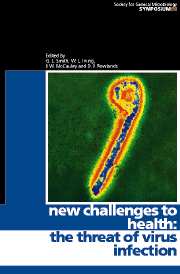Book contents
- Frontmatter
- Contents
- Contributors
- Editors' Preface
- 1 The viruses in our past, the viruses in our future
- 2 Dynamics and epidemiological impact of microparasites
- 3 The continuing threat of bunyaviruses and hantaviruses
- 4 Calicivirus, myxoma virus and the wild rabbit in Australia: a tale of three invasions
- 5 Potential of influenza A viruses to cause pandemics
- 6 The hepatitis viruses as emerging agents of infectious diseases
- 7 The emergence of human immunodeficiency viruses and AIDS
- 8 Morbilliviruses: dangers old and new
- 9 Structure–function analysis of prion protein
- 10 Endogenous retroviruses and xenotransplantation
- 11 Gammaherpesviral infections and neoplasia in immunocompromised populations
- 12 Structure and function of the proteins of Marburg and Ebola viruses
- 13 Epidemic dengue/dengue haemorrhagic fever as a public health problem in the 21st century
- 14 Borna disease virus – a threat for human mental health?
- 15 Antiviral drug development and the impact of drug resistance
- Index
7 - The emergence of human immunodeficiency viruses and AIDS
Published online by Cambridge University Press: 06 July 2010
- Frontmatter
- Contents
- Contributors
- Editors' Preface
- 1 The viruses in our past, the viruses in our future
- 2 Dynamics and epidemiological impact of microparasites
- 3 The continuing threat of bunyaviruses and hantaviruses
- 4 Calicivirus, myxoma virus and the wild rabbit in Australia: a tale of three invasions
- 5 Potential of influenza A viruses to cause pandemics
- 6 The hepatitis viruses as emerging agents of infectious diseases
- 7 The emergence of human immunodeficiency viruses and AIDS
- 8 Morbilliviruses: dangers old and new
- 9 Structure–function analysis of prion protein
- 10 Endogenous retroviruses and xenotransplantation
- 11 Gammaherpesviral infections and neoplasia in immunocompromised populations
- 12 Structure and function of the proteins of Marburg and Ebola viruses
- 13 Epidemic dengue/dengue haemorrhagic fever as a public health problem in the 21st century
- 14 Borna disease virus – a threat for human mental health?
- 15 Antiviral drug development and the impact of drug resistance
- Index
Summary
INTRODUCTION
The emergence of human immunodeficiency virus type 1 (HIV-1) in the human population is one of nature's most recent and highly successful adaptive radiations. This microbe illustrates Darwinian natural selection at a fast-forward pace. In the West, HIV readily exploited various niches of our late 20th century lifestyles, including air travel, narcotics dependence and steamy, promiscuous bath houses (Shilts, 1987). Yet it is wreaking most havoc among the world's poorest and underprivileged communities. HIV/AIDS presents a fascinating but frightening danse macabre of sex, drugs and death, with no end in sight to the burgeoning pandemic.
Of course, one does not need to be a microbiologist to know about AIDS. The disease was first recognized when small clusters of young homosexual men in American cities were reported to suffer rare opportunistic infections (OIs) (Pneumocystis carinii pneumonia, cytomegalovirus retinitis) and Kaposi's sarcoma (Centers for Disease Control, 1981). The underlying immune deficiency was soon shown to involve a selective depletion of CD4- positive, T-helper lymphocytes (Gottlieb et al., 1981). Initially, it was not clear whether ‘gay compromise syndrome’ as it was then named was transmissible or was related to non-infectious lifestyle factors. By early 1982, however, reports of AIDS in recipients of blood transfusions and pooled clotting factors, as well as among injecting drug users, indicated that an infectious agent was to blame. The appearance of AIDS in African countries and in Haiti suggested that the unknown pathogen was already widespread. In the past 20 years, the causative agent, HIV, has rampaged across the globe, with an estimated 53 million infected people among whom 19 million have died (Piot, 2000; UNAIDS, 2000b).
- Type
- Chapter
- Information
- New Challenges to HealthThe Threat of Virus Infection, pp. 125 - 154Publisher: Cambridge University PressPrint publication year: 2001
- 1
- Cited by



